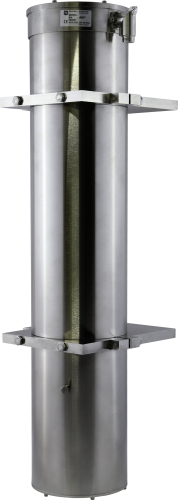This product is not available for new orders.

| Services Available |
|---|
Resumen
El CS725 mide el equivalente nieve-agua (SWE), detectando de forma pasiva el cambio que experimenta de forma natural la energía electromagnética del suelo al atravesar el manto de nieve. Se instala por encima del suelo y no tiene ningun contacto con la nieve. Al aumentar el grosor del manto de nieve, el sensor detecta la atenuación de la energía electromagnética emitida por la tierra, y así puede calcular el índice SWE. El área de medida del CS725 es de 50 a 100 metros cuadrados, siendo un excelente sustituto de los tradicionales "snow pillow" y "snow scale".
Aplicaciones típicas para el CS725:
- Predicción energía hidroeléctrica y potencial hidroeléctrico (Ver "Northern Canada: Hydro-electric Power Forecasting" case study.)
- Gestión de escorrentías estacionales
- Previsión de inundaciones y gestión de riesgos
- Planificación y gestión del riego
Ventajas y características
- Medida sin contacto
- Excelente sustituto de los tradicionales sensores snow-pillow
- No funde nieve ligera
- Reduce apreciablemente las visitas al lugar
- No es necesario preparar y trabajar el terreno
- Rendimiento no afectado por lluvia o nieve
- Efectivo para cualquier tipo de nieve o hielo
- No genera deslizamiento de nieve
- Siete años ciclo mantenimiento
- No requiere anticongelantes
Imágenes





Descripción detallada
The CS725 uses an innovative, non-contact method of measuring snow water equivalent (SWE). It passively detects the change in naturally occurring electromagnetic energy (mainly from the decay of 40K) from the ground after it passes through snow cover.
As SWE changes, the amount of energy that penetrates the snow pack changes—regardless of the state of the water (that is, liquid or frozen). A sensor installed above the ground prior to the first snowfall will have a base-line measurement of the electromagnetic energy coming from the ground. As snow accumulates and energy is attenuated, the SWE value will increase. The CS725 has an internal processor that determines the SWE and sends this information to a datalogger or communication device via RS-232.
Preguntas frecuentes
Número de FAQs relacionadas con CS725: 5
Expandir todoDesplegar todo
-
Yes, however the data would have to be back-calculated at the end of the season once all snow has melted, you would not have real-time SWE measurements.
-
The CS725 should be installed prior first snow fall to establish a good baseline reading. However, it can be installed after and the data back-calculated at the end of season. The only problem with this is you won’t have accurate SWE values during the season.
-
No, at this time the sensor does not output in SDI-12 format; however, it may be added in the future.
-
No, it only measures naturally emitted gamma radiation coming from the ground. The strongest signal of gamma comes from potassium-40 (40K).
-
The sensor takes the measurement and outputs data in RS-232 format. If your datalogger can receive RS-232 signals, it should work with the CS725. It’s also best that the datalogger can measure volumetric soil moisture.
Compatibilidad
Nota: lo siguiente muestra información de compatibilidad notable. No es una lista de todos los productos compatibles.
Dataloggers
| Producto | Compatible | Nota |
|---|---|---|
| CR1000 (retired) | ||
| CR3000 (retired) | ||
| CR6 | ||
| CR800 (retired) | ||
| CR850 (retired) |
Información de compatibilidad adicional
Collimator Considerations
Other sources of electromagnetic radiation (40K) such as trees, vegetation, and buildings that are not covered by the same amount of snow as the ground can affect the readings. To filter these signals, the optional heavy steel collar (collimator assembly, pn 29390) is installed on the bottom of the CS725.
The following chart outlines when a collimator should be used:
| Site Characteristics | Maximum SWE 300 mm | Maximum SWE 300 to 400 mm | Maximum SWE > 400 mm |
|
Very open site with no proximity to trees, buildings, or tall vegetation within a 48 m (160 ft) radius |
Optional |
Optional |
Optional |
|
No trees, buildings, or tall vegetation within a 24 m (80 ft) radius |
Optional |
Optional |
Required |
|
No trees, buildings, or tall vegetation within a 12 m (40 ft) radius |
Optional |
Required |
Required |
|
Site with minimum clearance radius of 6 m (20 ft) radius |
Required |
Required |
Required |
Note: Always confirm that your sensor has the “Collimator Installed” parameter set properly. The SWE calculations are different for a sensor with and without a collimator.
Especificaciones
| Measurement Range | 600 mm maximum water equivalent |
| Accuracy |
|
| Resolution | 1 mm |
| Coverage Angle | 60° |
| Operating Temperature Range | -40° to +40°C |
| Power Requirements | 11 to 15 Vdc |
| Power Consumption | 180 mA |
| Output Options | RS-232 (1200 to 115200 bps) |
| Cable Type | Four conductor, two-twisted pair, 22 AWG, Santoprene jacket |
| Warranty | 2 years |
| Maximum Cable Length | 30 m (98.43 ft) |
| Diameter | 12.7 cm (5 in.) |
| Length | 62 cm (24.4 in.) |
| Main Body Weight | 9 kg (20 lb) |
| Collimator Weight | 25 kg (55 lb) |
| Total Weight | 34 kg (75 lb) |
Documentos
Folletos producto
Manuales
Conformidad
Casos de aplicación
Climate change is an important global issue that poses challenges to many facets of our......leer más
System integrator Hortus Srl installed a Campbell Scientific CS725 SWE sensor (Snow Water Equivalent) in......leer más

